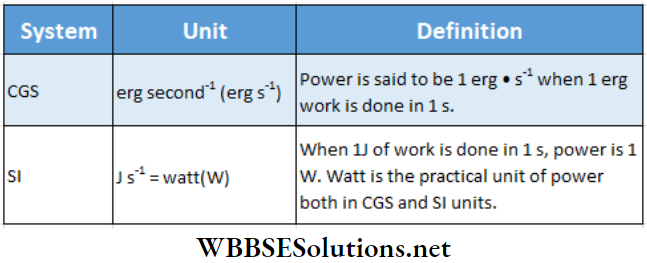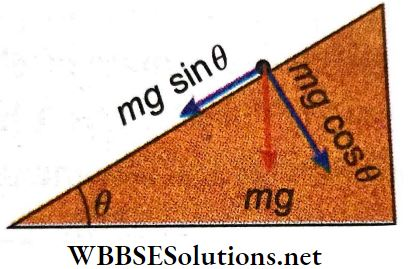Work And Energy
Power
Power Definition: The time rate at which work is done by a force is called power due to that force or simply work done per unit time is called power.
If W is the amount of work done by a force in the time interval t, then power, \(\bar{P}=\frac{W}{t}=\frac{\vec{F} \cdot \vec{s}}{t}=\vec{F} \cdot \vec{v}\)…(1)
In general, work may not be done at a uniform rate throughout the time t. So, equation (1) actually represents the average power.
On the other hand, if work is done at a variable rate i.e., work W( t) done by a force is a function of time (t), then power at any given instant or instantaneous power is more useful. Let dW be the work done in an infinitesimal time interval dt, then the instantaneous power is P = \(\frac{dW}{dt}\)…(2)
If in that interval dt an infinitesimal displacement \(d \vec{s}\) takes place, then dW = \(\vec{F} \cdot d \vec{s}\)
or, P \(=\frac{d W}{d t}=\vec{F} \cdot \frac{d \vec{s}}{d t}=\vec{F} \cdot \vec{v}=F v \cos \theta\); where, \(\vec{v}=\frac{d \vec{s}}{d t}\) = instantaneous velocity and θ = the angle between the direc¬tion of force applied and displacement.
Power Example: Suppose a robot does a work of 1000 erg in 5 s and another robot takes 10 s to do the same work. Hence, the power of the first robot = 1000/5 = 200 erg · s-1 and that of the second robot = 1000/10 = 100 erg · s-1.
Though both of them do the same amount of work, the power delivered by the first robot is greater.
Absolute Units And Dimension Of Power: We know, power = \(\frac{work}{time}\). So the unit of power depends on the units of work and time.
The power to do unit amount of work in a unit time is the unit of power.
Abtokito Units:

Abtokito Units Relations:
1W = 1 J · s-1 = 107 erg · s-1
1 kW = 103 W, 1 MW = 106 W
The practical unit of power in FPS system is horsepower (hp). When a mass of 550 lb is raised by 1 ft in 1 s against gravity, the power is 1 hp. The power of heat engines or electric motors are usually measured and expressed in horsepower.
So, 1 hp = 550 ft · lb · s-1
Relation Between Horsepower And Watt: 1 hp =550 ft · lb · s-1
= (500 x 30.48) cm x (453.6 x 981) dyn · s-1
= 746 x 107 erg · s-1 = 746 J · s-1 = 746 W
∴ 1 kW = \(\frac{1000}{746}\) = 1.34 hp.
Dimension:
Dimension of power = \(\frac{\text { dimension of work }}{\text { dimension of time }}\)
= \(\frac{M L^2 T^{-2}}{T}\)
= \(\mathrm{ML}^2 T^{-3}\)
Concept Of Power: Appliances used in our daily lives like electric bulbs, heaters, and motors are selected on the basis of their respective powers, and not of the total work that such devices can do. The power of a bulb is important as bulbs with higher wattage are more bright. The temperature of water can be raised faster with a high-power heater. The power ratings of appliances play a very important role in our practical lives.
Unit 4 Work Energy Power Chapter 1 Work And Energy
Power Numerical Examples
Example 1. A man of mass 50 kg climbs up 20 steps of a staircase in 5 s. Each step is 30 cm high. Find the power applied by the man.
Solution:
Height of 20 steps =20 x 30 = 600 cm = 6 m
∴ Work done = 50 x 9.8 x 6 = 2940 J [as m = 50 kg, g = 9.8 m · s-2]
∴ Power = \(\frac{2940}{5}\) J · s-1 = 588 W
Example 2. Find the power applied by a man of mass 70 kg, carrying a load of 45 kg, moving up at 6.4 km per hour along a plane of inclination \(\frac{1}{10}\).
Solution:
Velocity of the man, \(v=6.4 \mathrm{~km} \cdot \mathrm{h}^{-1}=\frac{6.4 \times 5}{18} \mathrm{~m} \cdot \mathrm{s}^{-1}\)
Total weight of the man and the load = (70 + 45)kg = 115 x 9.8 N
While moving up, the man has to work against the force mg sinθ

Hence, the power applied by the man, P = mg sinθ x v
= \(115 \times 9.8 \times \frac{1}{10} \times \frac{6.4 \times 5}{18}\)
[Here, tanθ = 1/10 ≈ sinθ (as θ is small)]
= 200.36 W
Example 3. Water is lifted to a vertical height of 90 m using a 7.46 kW engine. If the efficiency of the engine is 80%, find the amount of water lifted in a minute.
Solution:
Let the mass of water lifted per minute be m.
Effective power of the engine = 7.46 x 103 x 0.8 W
Now, work done per second = the effective power
∴ \(\frac{F s}{t}=\frac{m g s}{t}=7.46 \times 10^3 \times 0.8\)
or, m = \(7.46 \times 10^3 \times 0.8 \times \frac{t}{g s}\)
= \(\frac{7.46 \times 10^3 \times 0.8 \times 60}{9.8 \times 90}\)
(because \(t=1 \mathrm{~min}=60 \mathrm{~s}, g=9.8 \mathrm{~m} \cdot \mathrm{s}^{-2}, s=90 \mathrm{~m}\)) \(\approx 406 \mathrm{~kg}\)

